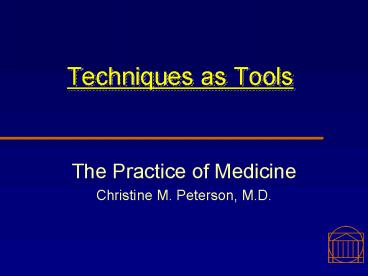Techniques as Tools - PowerPoint PPT Presentation
1 / 37
Title:
Techniques as Tools
Description:
... and functions of the medical interview. Learn non-verbal behaviors, ... Past Medical History. Family History. Social History. Review of Systems. Physical Exam ... – PowerPoint PPT presentation
Number of Views:30
Avg rating:3.0/5.0
Title: Techniques as Tools
1
Techniques as Tools
- The Practice of Medicine
- Christine M. Peterson, M.D.
2
Techniques as Tools
- Objectives
- Name purposes and functions of the medical
interview - Learn non-verbal behaviors, verbal techniques,
and responses - Practice using and observing skills
3
Techniques as Tools
- Week 1
- Introduction
- Non-verbal behavior
- Information- gathering
- Conveying empathy
- Week 2
- Background
- Video I
- Discussion
- Video II
- Discussion
4
Time Spent Relating to Patients (before DPI/PoM)
5
Time Spent Relating to Patients (with PoM)
6
Purposes of the Medical Encounter
- Help the patient by
- Relieving suffering
- Maximizing functioning
7
Basic Unit of Clinical Work
- History
- Chief Complaint
- History of Present Illness
- Past Medical History
- Family History
- Social History
- Review of Systems
- Physical Exam
8
Other Clinical Work
- Selection and interpretation of lab tests
- Diagnostic procedures
- Therapeutic procedures
9
Communication of Clinical Work
- Write-up (medical record, chart) and oral
presentation (rounds and consultation) - History
- Physical
- Laboratory Tests
- Differential Diagnosis ? Impression/Assessment
- Plan
10
Functions of the Medical Interview
- Gather data and understand
- Develop rapport and respond to emotions
- Educate and motivate
- Begin both diagnostic and healing processes
11
An Analogy
- A social conversation is to a medical interview
as...tying your shoes is
toperforming brain surgery.
12
The Patient-Centered Interview
- Focuses on the patients needs
- Activates the patient to play a larger role
- Is characterized by active listening
- Has a positive impact on patient outcome
13
- A good physician can talk to anyone
14
- But a great physician can listen to anyone.
15
Evidence Expressing Concerns
- Patients who express more of their concerns are
more satisfied and more likely to comply with
medical regimens - ? headaches, ? BP, ? days lost from work, ?
functional limitations - ? overall health ratings
- Same duration of interview!
16
Expressing Concerns
- Not really actually means Im not going to
tell you until I really know youll try to
understand what Im saying.
17
Evidence Specific Requests
- Often not obvious, not predictable
- When elicited ? more satisfaction whether or not
granted - Satisfaction more related to non-technical
interventions than technical ones
18
Mc Whinneys Taxonomy of Medical Help-Seeking
Behavior
- Limits of tolerance for symptom
- Limits of tolerance for anxiety about symptom
- Problems of living presenting as symptoms
- Preventive/routine care
- Administrative reasons
19
Evidence Patients Own Explanation of Illness
(Health Belief Model)
- Attending to patients beliefs ?better recall,
more commitment to Rx plan - Correlates with satisfaction
20
Evidence Patients Expression of Feeling
- M.D.s who express awareness of patients concerns
and feelings ? better outcome of care
21
Evidence Giving Patients Information
- Strong positive correlation between patient
satisfaction and perceived amount of information
received - Information-giving resulted in ? pain med
requirement and ? length of stay
22
Evidence Involving Patient in
Developing Treatment Plan
- Improved rate of kept follow-up appointments
- Improved functional capacity
- Improved physiologic parameters
23
Communication Factors That Increase Patient
Adherence
- Information exchange and patient education
- Negotiation of mutual expectation
- Ensuring patient plays an active role in the
interaction - Positive affect from the clinician
24
Communication Behaviors of No Claim Primary
Care Physicians
- Longer visits
- More orienting statements
- More humor, more laughter
- More facilitating comments
25
Patient-Centered Interview
- Allows patients to express their concerns
- Seeks patients specific requests
- Elicits patients explanations of their illnesses
- Facilitates patients expression of feeling
- Gives patients information
- Involves patients in developing a plan for
evaluation and treatment - IMPROVES SATISFACTION AND OUTCOME
26
Non-Verbal Behavior(Behavior that BEFITS a
physician)
- Body posture and movements
- Eye contact
- Facial expression
- Inflection, tone of voice and rate of speech
- Touch
- Space between doctor and patient
27
Non-Verbal Behavior(Behavior that BEFITS a
physician)
- Body posture and movements
- Eye contact
- Facial expression
28
Non-Verbal Behavior(Behavior that BEFITS a
physician)
- Inflection, tone of voice and rate of speech
- Touch
- Space between doctor and patient
29
Verbal Techniques That Enhance
Information-Gathering
- (FOCUS on information)
- Facilitations
- Open-ended questions
- Clarification and direction
- Understanding by checking
- Surveying problems
30
Verbal Techniques That Enhance
Information-Gathering
- (FOCUS on information)
- Facilitations
- Open-ended questions
- Clarification and direction
31
Verbal Techniques That Enhance
Information-Gathering
- Understanding by checking
- Surveying problems
32
More Information
- (PREP for more information)
- Priorities for the patient
- Expectations that the patient has
- Patients ideas about the meaning of the illness
33
Non-verbal and verbal techniques
- BEFITS
- FOCUS
- PREP
34
Process of Empathy
- Four stages
- Identification
- Incorporation
- Reverberation
- Detachment
35
Skills that Convey Empathic Understanding
- (REALLY PREPARE for understanding)
- Reflection
- Legitimation
- Personal support
- Partnership
- Respect
36
- A good physician can talk to anyone
37
- But a great physician can listen to anyone.































